6 Advanced Sudoku Expert Techniques | Master Sudoku: From Beginner to Expert - Class 1 PDF Download
6 Advanced Sudoku Strategies
Advanced Sudoku strategies are used in the hardest levels of these puzzles and they can either help to reduce candidates or find the solution for a specific cell. Regardless, their application always demands high levels of concentration from the player as they work by deduction.
1. The X-Wing - The Flying Trick
This trick is used to remove wrong numbers.
If you see the same number in 4 boxes forming a rectangle, you can imagine an “X” inside the square!
Now check: if only two pairs are possible (like green and yellow), try both.
- If a number doesn’t work in both cases in another box, you can erase it.
- It’s like spotting wings of an X and flying to the right answer
The X-Wing method is one of the most basic advanced Sudoku strategies. It can also be applied at some intermediate levels, although its incidence is very low in these cases. Its goal is to eliminate candidates.
The player can use this strategy when there is one candidate repeated in four cells that form a square or rectangle when mentally connected by row and column. By making an X linking diagonally the two opposite corners of this rectangle, the player finds only two possible sets of positions for that digit.
The next step will be to test those sets on the grid and eliminate the digit from any cell that would become impossible in both situations. Example:
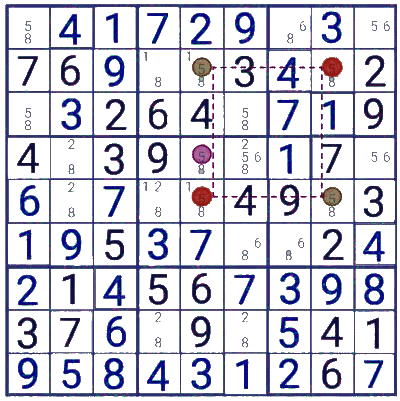
In this example, the number 5 forms the necessary pattern to apply the X-Wing strategy. By connecting the cells containing it, it is easy to see that in this situation only the pairs in green or yellow could be possible. Testing the pairs on the grid shows that the 5 highlighted in red would be impossible in both cases. It can then be eliminated as a candidate for that cell.
2. The Swordfish - The Swishy Trick
Another way to remove a wrong number.- Look for a number that is in two boxes in 3 different rows.
- These boxes should line up in columns — like a fish shape!
- Now check: if a number doesn’t work in both possible paths, erase it from that box.
- It swims through the puzzle like a smart swordfish!
Example
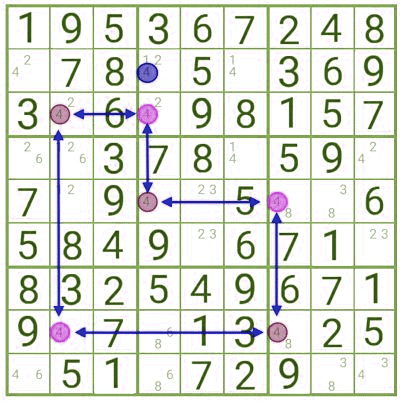
In this grid, number 4 is a candidate for two cells in three different rows, allowing the player to use the Swordfish technique.
Connecting them reveals that whenever a digit highlighted in green is possible, the yellows become impossible, and vice-versa. Thus, there are only two sets of possibilities within this chain for number 4, the green and the yellow sets.
When testing them on the grid, the player finds that the 4 highlighted in red would be an impossible candidate in both cases. It can then be safely removed from that cell, leaving only numbers 1 and 2 as candidates for it.
3. Forcing Chains - The Guess and Check Trick
This trick helps you find the right number by testing both choices.- If a box has only two choices (like 1 or 2), try both.
- See what happens next with each choice.
- If you find another box where both choices give the same answer, that’s the right number for that box!
- It’s like following two paths and seeing where both lead!
Example:
In this example, the top highlighted cell with the candidates 1 and 2 was used to apply the forcing chains technique. When testing for both digits, the player finds that the outcome for the highlighted cell with candidates 5 and 7 is always 5. Therefore, this digit will be the solution for that particular cell.
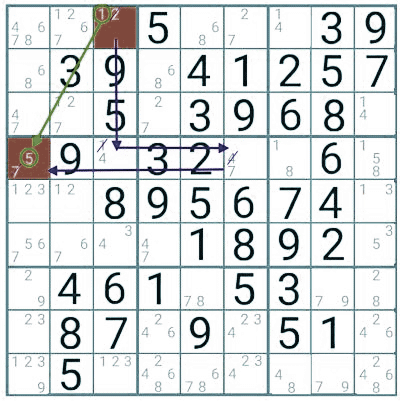
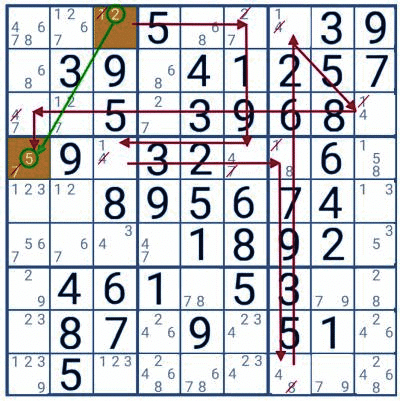
Note that when testing for number 1, the player could also have made a chain by going right (to the cell with 1 and 4 as candidates). The chain would be longer, but the result is the same. Then number 5 is still the answer to the highlighted cell.
Out of the advanced Sudoku strategies, the forcing chains method is usually a last resort as the chains can be very long and complicated and they do not always produce results.
4. The XY-Wing - The Y-Shaped Trick
This trick is used to remove wrong guesses.- Find three boxes with two numbers each (like 2-9, 2-1, 1-9).
- Connect them to make a Y shape.
Now look: if a number is common and appears at the meeting point, you can erase it from that box!
- It’s like a wishbone — helps you pick the lucky side!
Example
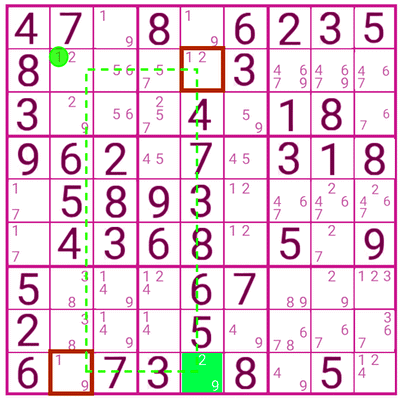
In the example above, the stem cell contains the digits 2 and 9 (highlighted in orange) and connects to the branches, each with one of these digits as candidates (purple squares).
- If any of the cells on the red paths contained one candidate shared by the cells on the extremities of the lines, it could be eliminated, but this is not the case.
- However, the cell at the intersection of both branches of the Y contains a shared digit between both (number 1), allowing the player to eliminate it as a candidate for that cell.
5. Unique Rectangle Type 1
Every Sudoku puzzle should have only one correct solution.But in very hard puzzles, players might sometimes find two possible answers. This happens because of something called a "deadly pattern".
What is a deadly pattern?
- It happens when there are 4 boxes (cells) that have the same two numbers as choices.
- These boxes are placed in a rectangle shape and are all in the same row, column, or 3x3 box.
- If this pattern is not fixed, it can lead to more than one answer, which is not allowed.
So what’s the trick?
Use the Unique Rectangle strategy:
- Look at the 4 boxes and see if one of them has an extra number as a choice.
- If yes, that extra number is the key!
- You can remove the two repeated numbers from that box.
- This helps to stop the deadly pattern and keeps the puzzle having only one right solution.
Example
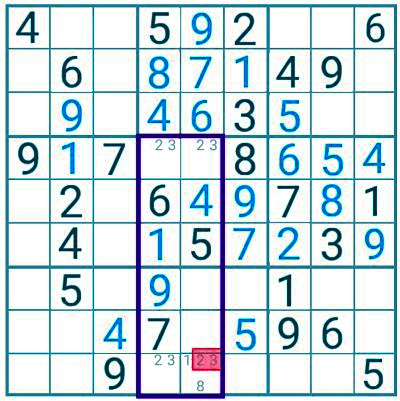
6. Nishio
The Nishio Strategy – A Tricky Sudoku MethodThe Nishio strategy is named after a puzzle expert called Tetsuya Nishio, who came up with this idea.
Among all the hard Sudoku tricks, this one is used the least because it’s based on guessing and is a bit risky.
Here’s how it works:
- Look at a box that has only two possible numbers.
- Pick one number and try solving the puzzle using that.
- If the puzzle works out, good job!
- But if something goes wrong, you go back and try the other number instead.
- If the first number causes a problem, you know it’s wrong — so the other number must be correct!
But be careful!
- If you make even a small mistake, you might not be able to solve the puzzle at all.
- Also, the problem might not show up until the very end, which can waste a lot of time.
That’s why most players use this strategy only when they really need to.
Learning how to use tricks like Nishio is not too hard — but the real challenge is finding the right places to use them.
Usually, only expert players use these methods when the puzzle is very difficult.
|
9 videos|46 docs
|
















